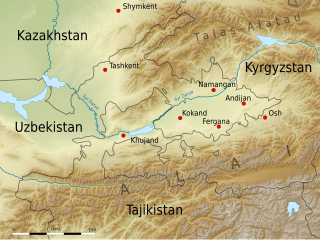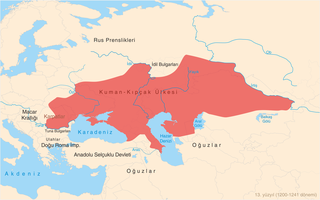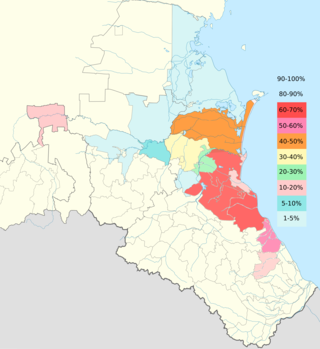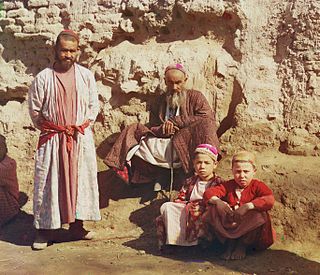Related Research Articles

The Turkic languages are a language family of more than 35 documented languages, spoken by the Turkic peoples of Eurasia from Eastern Europe and Southern Europe to Central Asia, East Asia, North Asia (Siberia), and West Asia. The Turkic languages originated in a region of East Asia spanning from Mongolia to Northwest China, where Proto-Turkic is thought to have been spoken, from where they expanded to Central Asia and farther west during the first millennium. They are characterized as a dialect continuum.

Uzbek, formerly known as Turki, is a Karluk Turkic language spoken by Uzbeks. It is the official and national language of Uzbekistan and formally succeeded Chagatai, an earlier Karluk language also known as "Turki", as the literary language of Uzbekistan in the 1920s.

Kyrgyz is a Turkic language of the Kipchak branch spoken in Central Asia. Kyrgyz is the official language of Kyrgyzstan and a significant minority language in the Kizilsu Kyrgyz Autonomous Prefecture in Xinjiang, China and in the Gorno-Badakhshan Autonomous Region of Tajikistan. There is a very high level of mutual intelligibility between Kyrgyz, Kazakh, and Altay. A dialect of Kyrgyz known as Pamiri Kyrgyz is spoken in north-eastern Afghanistan and northern Pakistan. Kyrgyz is also spoken by many ethnic Kyrgyz through the former Soviet Union, Afghanistan, Turkey, parts of northern Pakistan, and Russia.

The Bashkirs or Bashkurts are a Kipchak-Bulgar Turkic ethnic group indigenous to Russia. They are concentrated in Bashkortostan, a republic of the Russian Federation and in the broader historical region of Badzhgard, which spans both sides of the Ural Mountains, where Eastern Europe meets North Asia. Smaller communities of Bashkirs also live in the Republic of Tatarstan, the oblasts of Perm Krai, Chelyabinsk, Orenburg, Tyumen, Sverdlovsk and Kurgan and other regions in Russia; sizable minorities exist in Kazakhstan and Uzbekistan.

Kyrgyzstan, officially the Kyrgyz Republic, is a landlocked country in Central Asia, lying in the Tian Shan and Pamir mountain ranges. Bishkek is the capital and largest city of the country. Kyrgyzstan is bordered by Kazakhstan to the north, Uzbekistan to the west, Tajikistan to the south, and China to the east and southeast. Ethnic Kyrgyz make up the majority of the country's 7 million people, followed by significant minorities of Uzbeks and Russians.

The Fergana Valley in Central Asia lies mainly in eastern Uzbekistan, but also extends into southern Kyrgyzstan and northern Tajikistan.

The Kipchaks or Qipchaks, also known as Kipchak Turks or Polovtsians, were Turkic nomads and then a confederation that existed in the Middle Ages inhabiting parts of the Eurasian Steppe.
Cuman or Kuman was a West Kipchak Turkic language spoken by the Cumans and Kipchaks; the language was similar to today's various languages of the West Kipchak branch. Cuman is documented in medieval works, including the Codex Cumanicus, and in early modern manuscripts, like the notebook of Benedictine monk Johannes ex Grafing. It was a literary language in Central and Eastern Europe that left a rich literary inheritance. The language became the main language of the Golden Horde.

Osh is the second-largest city in Kyrgyzstan, located in the Fergana Valley in the south of the country and often referred to as the "capital of the south". It is the oldest city in the country and has served as the administrative center of Osh Region since 1939. The city has an ethnically mixed population of 322,164 in 2021, comprising Kyrgyz, Uzbeks, Ukrainians, Koreans, and other smaller ethnic groups.

Kumyk is a Turkic language spoken by about 426,212 people, mainly by the Kumyks, in the Dagestan, North Ossetia and Chechen republics of the Russian Federation. Until the 20th century Kumyk was the lingua-franca of the Northern Caucasus.

Rishton is a city in Fergana Region, in Uzbekistan. It is the administrative center of Rishton District. Its population is 34,800 (2016). It is located about halfway between Kokand and Fergana at latitude 40°21'24N longitude 71°17'5E, and at an elevation of 471 meters.

Sart is a name for the settled inhabitants of Central Asia which has had shifting meanings over the centuries.
The Cumans-Kipchaks in Georgia are of an ancient nomadic Turkic people who inhabited large territories from Central Asia to Eastern Europe. They played an important role in the history of many nations in the region, Georgia among them. At the height of this Caucasian power from the 12th to the 13th centuries, Georgian monarchs recruited thousands of Kipchak/Cuman mercenaries and successfully exploited their service against the neighboring Muslim states.

Soviet Central Asia was the part of Central Asia administered by the Soviet Union between 1918 and 1991, when the Central Asian republics declared independence. It is nearly synonymous with Russian Turkestan in the Russian Empire. Soviet Central Asia went through many territorial divisions before the current borders were created in the 1920s and 1930s.
The Kipchak languages are a sub-branch of the Turkic language family spoken by approximately 30 million people in much of Central Asia and Eastern Europe, spanning from Ukraine to China. Some of the most widely spoken languages in this group are Kazakh, Kyrgyz, and Tatar.

Kyrgyzstan is one of four former Soviet republics in Central Asia to have Russian as a de jure official language. The Kyrgyz language was adopted as the official language in 1991. After pressure from the Russian and other minorities in the country, the republic adopted Russian as an official language as well in 1997, to become an officially bilingual country.
The Osh riots were an ethnic conflict between Kyrgyz and Uzbeks that took place in June 1990 in the cities of Osh and Uzgen, part of the Kirghiz SSR. The immediate cause of the riots was a dispute between an Uzbek nationalist group Adolat and a Kyrgyz nationalist group Osh Aymaghi over the land of a former collective farm. While official estimates of the death toll range from over 300 to more than 600, unofficial figures range up to more than 1,000. The riots have been seen as a forerunner to the 2010 ethnic clashes in the same region.
Siberian Tatar (Сыбырца) is a Turkic language spoken in Western Siberia, Russia, primarily in the oblasts of Tyumen, Novosibirsk, Omsk but also in Tomsk and Kemerovo. According to Marcel Erdal, due to its particular characteristics, Siberian Tatar can be considered as a bridge to Siberian Turkic languages.
The Crimean Tatar language consists of three dialects. The standard language is written in the middle dialect, which is part of the Kipchak-Cuman branch. There is also the southern dialect, also known as the coastal dialect, which is in the Oghuz branch, and the northern dialect, also known as nogai dialect, which is in the Kipchak-Nogai branch.